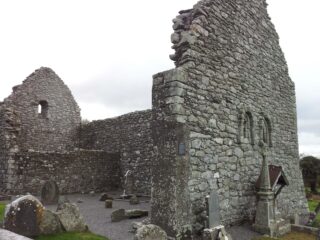Notice
Aghowle Church is a state-owned National Monument in the care of the Office of Public Works
WARNING: It should be noted that these sites are unguided and a level of care and caution should be maintained during all stages of your visit. The Office Of Public Works (OPW) will not be held responsible for any damages, injuries, or losses that occur
Aghowle Church
Aghowle Church is located 8.5 kilometres (5.3 miles) northwest of the Co. Wicklow village of Shillelagh, and 11.8 kilometres (7.3 miles) southeast of the Co. Carlow village of Tullow.
Aghowle translates from the Irish "Achadh na Abhall" as "The field of apple trees". It was the reputed site of a monastery, where many monks lived, that was founded in the first quarter of the 6th century by St. Finnian of Clonard, Co. Meath, who died in c.550 AD. Known as the "Teacher of the Saints", amongst his most noteworthy students was St. Columba, also known as St. Colmcille.
This tall austere 12th century Hiberno-Romanesque stone church, or damhliag in Irish, is one of the largest of its era. It measures 18.3 meters (60 feet) long by 7.32 meters (24 feet) wide, the customary ground measurement of the primatial Irish cathedrals and principal abbey churches. The rectangular structure has unusually high gable ends of approximately 10.67 meters (35 feet) to each apex. The original north, east and west walls survive and are 0.92 meters (3 feet) thick, but most of the south wall was demolished before 1839 to build a cross wall at the west end, enclosing a burial ground for the Nickson family of nearby Munny. Also within this enclosure, fixed on the right hand side of the west end wall, is a large though partially broken memorial slab, erected by Lorenzo Hodson, of Coolker, a relation of the Nicksons, in memory of various members of his family.
Although now only affording access to the Nixon and Hosdon burial place, the church was originally entered through a west-facing trabeated or flat-headed lintelled granite doorway, typical of the construction of very early churches. The entrance has Romanesque moulded beading on the outside and a round arch inside. On the outside of east gable are two round-headed windows with hood-mouldings supported by pillars. On each of the two pillar bases of one of the windows are crudely-carved dog-like monsters’ faces. Two corbels on each side of the west end of the church suggest that a timber croft or gallery once existed, lighted by the small window that is set high above the entrance doorway.
Substantial restoration works were carried out on the church by the Board or Works in 1887, including the removal of a large covering of ivy and the buttressing of the corner of the east gable where it joins the north wall.
Unusually for an ecclesiastical site of this period there is no remaining evidence of the existence of a bell tower, or Cloichteach, but local legend tells of a "fugitive bell". The story goes that St. Finnian erected a belfry at Aghowle and in it he placed a magnificent bell, whose ringing tone was as sweet as had ever been heard, which was rung to summon the community and the congregation to prayer. The holy abbot Maidoc, of nearby Clonmore, coveted the bell and wearied St. Finnian with pleas to possess it. St. Finnian had by now moved to his new church at Clonard, in Co. Meath, and, for fear that Maidoc would claim it, decided to place the bell in the belfry there. On the morning after it was installed the bellringer discovered that it was gone, while the bell-ringer at Aghowle found it back in its usual place. Several times St. Finnian brought the bell back to Clonard but each next morning it was back in its original location. For generations after the saint’s death the bell tolled worshipers to their religious devotions in the secluded monastery. To this day the legend holds that the bell, supposedly cast in pure gold, is buried somewhere near the church.
To the northeast of the church is a 2.8 metre (9 foot 2 inch) c.10th century unperforated granite high cross, standing on a pyramidal base, and known as St. Finden's Cross. Beside it is a large granite baptismal font which local tradition claims that the water from it provides a cure for headaches.
In the field to the southeast of the church is a large bullaun stone, such as many that are found nearby to ancient churches and holy sites. Folklore describes them as both curing and cursing stones and some tales suggest that the rainwater collected in their central depressions has healing powers.
Protect our Past - Click here to read about the importance of protecting our country’s unique heritage sites
This national monument is protected in accordance with the National Monuments Acts 1930 to 2014
Gallery
Nearby sites to visit
Altamont Gardens
Old-world gardens with an atmosphere all of their own
Approx. 7.8 km from Aghowle Church
Ferns Castle
Two nations, two cultures and one shared heritage
Approx. 21.3 km from Aghowle Church
Dwyer McAllister Cottage
An unlikely battle-site of the 1798 Rebellion
Approx. 21.9 km from Aghowle Church
Glendalough Monastic Site and Visitor Centre
A valley of sanctuary for saints and scholars
Approx. 33.5 km from Aghowle Church
St. Mary’s Church Gowran
Records written in stone in the heart of Gowran
Approx. 33.7 km from Aghowle Church
National Botanic Garden of Ireland – Kilmacurragh
An oasis of rare horticultural delights
Approx. 36.4 km from Aghowle Church




